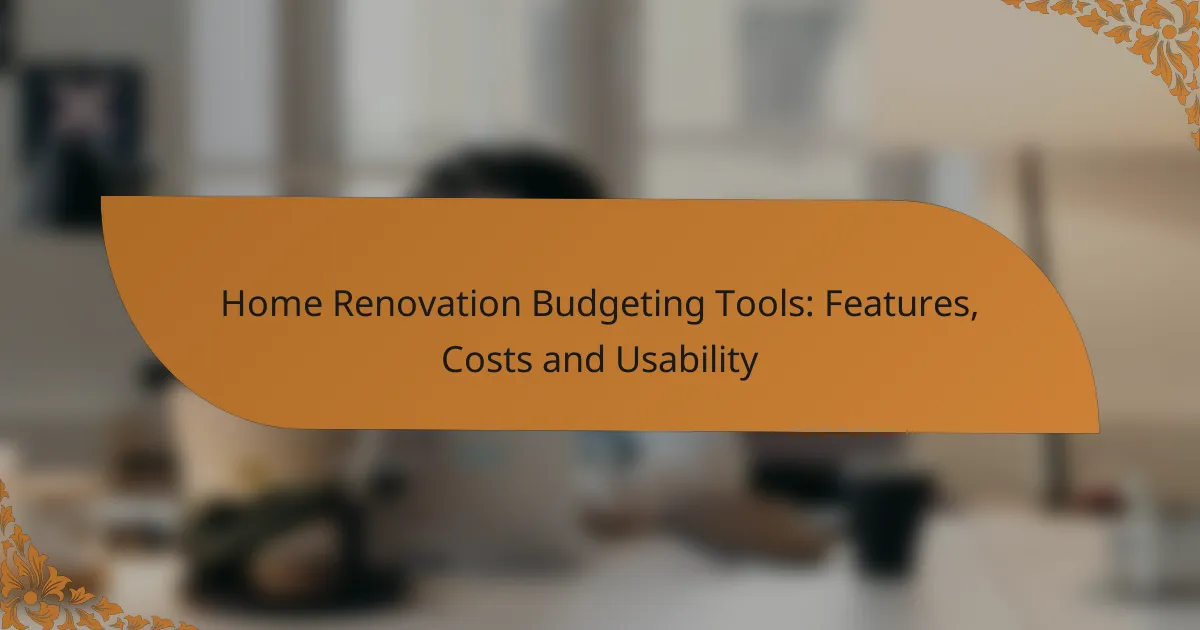Home renovation budgeting tools are essential for homeowners looking to estimate costs, track expenses, and manage their projects efficiently. With a range of features, usability options, and pricing structures, selecting the right tool is crucial for aligning with your renovation goals and financial plan.

What are the best home renovation budgeting tools?
The best home renovation budgeting tools help homeowners estimate costs, track expenses, and manage their renovation projects effectively. These tools vary in features, usability, and pricing, making it essential to choose one that fits your specific needs.
HomeAdvisor Budgeting Tool
The HomeAdvisor Budgeting Tool is designed to help homeowners estimate renovation costs based on their project type and location. Users can input details about their renovation, and the tool provides a cost range based on local averages.
This tool also offers access to local contractors, making it easier to compare quotes and find professionals who fit your budget. Keep in mind that while the estimates are helpful, actual costs may vary based on specific project details and contractor pricing.
Houzz Project Cost Calculator
The Houzz Project Cost Calculator allows users to estimate costs for various renovation projects by selecting specific features and materials. It provides a breakdown of expenses, helping users understand where their budget will be allocated.
One advantage of this tool is its integration with Houzz’s extensive database of products and professionals, enabling users to visualize their project while budgeting. However, be cautious as the final costs can differ significantly from the estimates due to personal choices and market fluctuations.
Renovation Budget Planner
The Renovation Budget Planner is a straightforward tool that helps users create a detailed budget by listing all potential expenses. Users can categorize costs into labor, materials, permits, and unexpected expenses to get a comprehensive view of their financial needs.
This planner is particularly useful for those who prefer a hands-on approach to budgeting, as it allows for customization and adjustments as the project progresses. Remember to regularly update your budget as you receive quotes and make decisions to ensure accuracy.
BuildZoom Cost Estimator
The BuildZoom Cost Estimator provides users with a detailed analysis of renovation costs based on historical data from similar projects. By entering project specifics, users can receive a tailored estimate that reflects local market conditions.
This tool is beneficial for homeowners looking to understand the cost implications of their renovation decisions. However, it’s essential to validate the estimates with local contractors to ensure they align with current pricing trends.
RoomSketcher Budgeting Software
RoomSketcher Budgeting Software combines design and budgeting features, allowing users to create floor plans while estimating costs. This dual functionality helps homeowners visualize their renovation while keeping track of expenses.
The software is user-friendly and offers various templates to simplify the budgeting process. However, users should be aware that while it aids in planning, the final costs may vary based on actual material choices and labor rates. Regularly revisiting the budget as plans evolve is crucial for staying on track financially.

How much do home renovation budgeting tools cost?
Home renovation budgeting tools can vary significantly in cost, ranging from free options to subscription-based services and one-time purchases. Understanding these costs helps you choose a tool that fits your financial plan and renovation needs.
Free options available
Many free budgeting tools are accessible online, offering basic features for tracking expenses and managing budgets. These tools often include spreadsheets or simple apps that allow users to input costs and monitor spending.
While free options can be useful for small projects, they may lack advanced features such as detailed reporting, integration with other financial tools, or customer support. Consider your project complexity when deciding if a free tool meets your needs.
Subscription-based tools pricing
Subscription-based budgeting tools typically charge a monthly or annual fee, ranging from around $5 to $30 per month. These tools often provide more comprehensive features, including expense tracking, project timelines, and collaboration with contractors.
When choosing a subscription service, evaluate the features offered and whether they justify the recurring cost. Many services offer free trials, allowing you to test functionality before committing.
One-time purchase tools
One-time purchase tools usually cost between $20 and $150, depending on the complexity and features included. These tools often come as downloadable software, providing a straightforward way to manage renovation budgets without ongoing fees.
While one-time purchases can be cost-effective, ensure that the tool offers sufficient updates and support. Check user reviews to gauge the tool’s effectiveness and reliability before making a purchase.

What features should I look for in budgeting tools?
When selecting budgeting tools for home renovation, focus on features that enhance accuracy, usability, and integration with other project management systems. Key aspects include cost estimation capabilities, a user-friendly interface, mobile accessibility, and seamless integration with project management tools.
Cost estimation capabilities
Effective budgeting tools should provide robust cost estimation features that allow you to input various project parameters and receive accurate financial projections. Look for tools that can break down costs into categories such as materials, labor, and permits, which can help you identify potential overspending areas.
Some tools offer historical data analysis, allowing you to compare current estimates with past projects. This can provide a more realistic budget based on actual costs rather than just estimates, helping you stay within your financial limits.
User-friendly interface
A user-friendly interface is crucial for ensuring that you can navigate the budgeting tool easily. Look for intuitive designs that allow for quick access to features without extensive training. Tools with drag-and-drop functionalities or simple dashboards can significantly enhance your experience.
Consider tools that offer customizable views or templates tailored to home renovation projects. This can save you time and make it easier to track your budget effectively.
Integration with project management
Choosing budgeting tools that integrate well with project management software can streamline your renovation process. This integration allows for real-time updates on budget changes and project timelines, ensuring that all team members are on the same page.
Look for tools that can sync with popular project management platforms like Trello or Asana. This can help you manage tasks and budgets simultaneously, reducing the risk of miscommunication and budget overruns.
Mobile accessibility
Mobile accessibility is essential for managing your renovation budget on the go. Tools that offer mobile apps or responsive web designs enable you to update your budget and track expenses from anywhere, which is particularly useful during site visits.
Check for features like offline access and push notifications for budget alerts, which can help you stay informed about your spending even when you are not connected to the internet. This flexibility can prevent overspending and keep your project on track.

How do home renovation budgeting tools improve usability?
Home renovation budgeting tools enhance usability by simplifying the financial management of projects, making it easier for users to track expenses and allocate funds effectively. These tools provide organized interfaces that help homeowners visualize their budgets and make informed decisions throughout the renovation process.
Streamlined project tracking
Streamlined project tracking allows users to monitor expenses in real-time, ensuring that they stay within budget. Many tools offer features like expense categorization and progress tracking, which help users see how much they’ve spent versus their budgeted amounts.
For example, a homeowner might use a budgeting tool to categorize costs into materials, labor, and permits, making it easier to identify areas where they can cut back if necessary. This organized approach can prevent overspending and help maintain financial control.
Visual budgeting aids
Visual budgeting aids, such as graphs and charts, provide a clear representation of spending patterns and budget allocations. These visual tools help users quickly grasp their financial situation at a glance, making it easier to identify trends or areas needing attention.
For instance, a pie chart might show how much of the total budget is allocated to different aspects of the renovation, like kitchen upgrades or bathroom remodels. This visual clarity can guide decision-making and prioritization of expenses.
Collaboration features
Collaboration features enable multiple stakeholders, such as homeowners, contractors, and designers, to work together seamlessly on budgeting. These tools often include shared access to project budgets, allowing everyone involved to stay informed and aligned on financial matters.
For example, a homeowner can invite their contractor to view and edit the budget, ensuring that both parties have a clear understanding of costs and can adjust plans as needed. This collaborative approach reduces misunderstandings and fosters a more efficient renovation process.

What are the prerequisites for using budgeting tools?
To effectively use budgeting tools for home renovation, you need a clear understanding of your project scope, financial situation, and the specific features of the tools available. Familiarity with basic budgeting concepts and access to relevant financial data will enhance your experience and outcomes.
Understanding your renovation goals
Before selecting a budgeting tool, define your renovation goals clearly. This includes identifying which areas of your home you want to renovate, the desired outcomes, and the overall budget range you are willing to allocate. Having specific goals helps in choosing a tool that aligns with your project needs.
For example, if you aim to remodel a kitchen, consider the costs associated with materials, labor, and permits. This clarity will guide you in setting realistic financial expectations and using the budgeting tool effectively.
Gathering financial information
Collecting your financial information is crucial for accurate budgeting. This includes your current income, savings, and any potential financing options such as loans or credit. Understanding your financial landscape allows you to input realistic figures into the budgeting tool.
Consider creating a simple spreadsheet to track your income and expenses. This can help you identify how much you can allocate toward your renovation project without straining your finances.
Familiarity with budgeting tools
Different budgeting tools offer various features, so it’s important to familiarize yourself with them before starting. Look for tools that allow you to input costs, track expenses, and adjust budgets as needed. Some tools may also provide templates specifically designed for home renovations.
Explore online reviews or trial versions to find a tool that suits your preferences. Popular options may include mobile apps or web-based platforms that offer user-friendly interfaces and helpful budgeting features.
